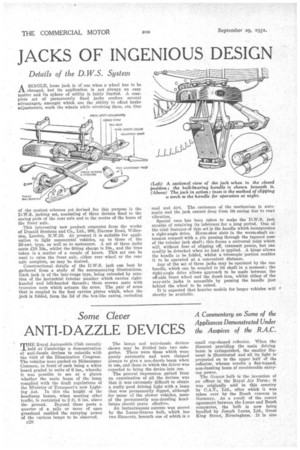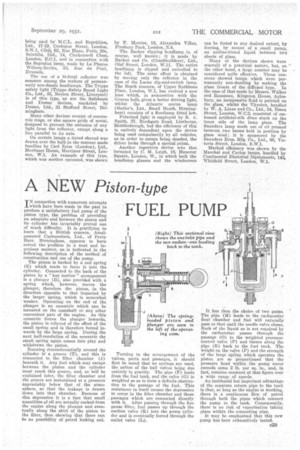S ome Clever A Commentary on Some of the
Page 50

Page 51

If you've noticed an error in this article please click here to report it so we can fix it.
Appliances Demonstrated Under
ANTI-DAZZLE DEVICES the Auspices of the R.A.C.
THE Royal Automobile Club recently held at Cambridge a demonstration of anti-dazzle devices to coincide with the visit of the Illumination Congress. The vehicles were parked on Midsummer Common, in front of each being a white board graded in units of 6 ins., whereby it was possible to see at a glance whether the main beam of the lamp complied with the draft regulations of the Ministry of Transport's new Lighting Act. In this the height of the headlamp beams, when meeting other traffic, is restricted to 2 ft. 6 ins, above the ground. Beyond these posts a quarter of a mile or more of open grassland enabled the carrying power of the various lamps to be observed.
C28 The lamps and anti-dazzle devices shown may be divided into two categories. There were those which were purely automatic and were claimed always to give a non-dazzle beam when in use, and those in which the driver was expected to bring the device into use.
The general impression gained from an examination of all the devices was that it was extremely difficult to obtain a really good driving light with a lamp that was permanently dipped, although for many of the slower vehicles, some of the permanently non-dazzling headlamps should prove effective.
An instantaneous success was senTed by the Lucas-Graves bulb, which has two filaments, beneath one of which is a small cup-shaped reflector. When the filament providing the main driving beam is extinguished, the smaller filament is illuminated and all its light is projected on to the upper half of the reflector, whence results a fiat-topped, non-dazzling beam of considerable carrying power.
The Graves bulb is the invention of an officer in the Royal Air Force; it was , originally sold in this country by C.A.V., Ltd., after which it was taken over by the Bosch concern in Germany. As a result of the recent agreement between_ the Lucas and Bosch companies, the bulb is now being handled by Joseph Lucas, Ltd., Great King Street, Birmingham. It is also being used by M.C.L..and Repetition, Ltd., 17-19,, Cockspur Street, London, S.W.1, Cibie, 62, Rue Haxo, Paris, 20e, Scintilla, Ltd., 14, Clerkenwell Close, London, E.C.1, and in connection with the Supralux lamp, made by Le Phares Willocq-Botein, 53, Rue du Pont, Brussels.
The use of a hi-focal reflector was common among the makers of permanently non-dazzle headlamps. The Trippe safety light (Trippe Safety Speed Light Co., Ltd., 35, Norton Street, Liverpool) is of this type, as are the Safebeatn and Desmo devices, marketed by Desmo, Ltd., 31 Stafford Street, Birmingham.
Many other devices consist of concentric rings, or else square grids of metal, designed to prevent the emission of any light from the reflector, except along a line parallel to its axis.
On certain lamps a tinted shroud was drawn over the bulb in the manner made familiar by Carl Zeiss (London), Ltd., Mortimer Ilause, Mortimer Street, London, W.1. An example of this type, which was suction operated, was shown
by F: Morriss, 18, Alexandra Villas, Finsbury Park, London, N.4.
The Barker dipping headlamp is, of course, well known ; it is made by Barker and Co. (Coachhuilders), Ltd., Olaf Street, London, W.11. The entire headlamp is dipped and swivelled to the left. The same effect is obtained by moving only the reflector in the ease of the Lucas dip-and-switch lamp. The Bosch concern, of Upper Rathbone Place, London, W.1, has evolved a new lens which, in jconnection with the Graves bulb, gives a better driving light, whilst the Atlantic centre lamp (Butler's, Ltd., Small Heath, Birmingham) consists of a floodlamp fitted low.
Polarized light is employed by R. A. Smith, 37, Birchgate Road, Linthorpe, Middlesbrough, but the efficiency of this is entirely dependent upon the device being used compulsorily by all vehicles, as in order to escape being dazzled, the driver looks through a special prism.
Another ingenious device was that invented by C. M. Leigh, 16, Hanover Square, London, W., in which both the headlamp glasses and the windscreen
can be tinted to any desired extent, by forcing, by means of a small pump, an aniline-tinted liquid . between two sheets of glass.
Many of the devices shown were scarcely of a practical nature, but, on the other hand, a large number may be considered quite effective. Three concerns showed lamps which were permanently non-dazzling by making the glass fronts of the diffused type. In the case of that made by Messrs. Walker and Rousseau, Kingston House, Aylesbury, an inexpensive fluid is painted on the glass, whilst the Vitrolux, handled by W. A. Lines and Co., Ltd., 24, Essex Street, London, W.C.2, consisted of embossed artificial-silk discs stuck on the inner side of the lamp glass. The Saunders lamp made use of oil pressed between two lenses held in position by glass wool ; it is sponsored by the Saunders Bros. Mfg. Co., Ltd., 66, Victoria Street, London, S.W.1.
Marked efficiency was shown by the Marchal and Cyclop lamps, handled by Continental Electrical Equipments, 143, Whitfield Street, London, W.1.












































































































